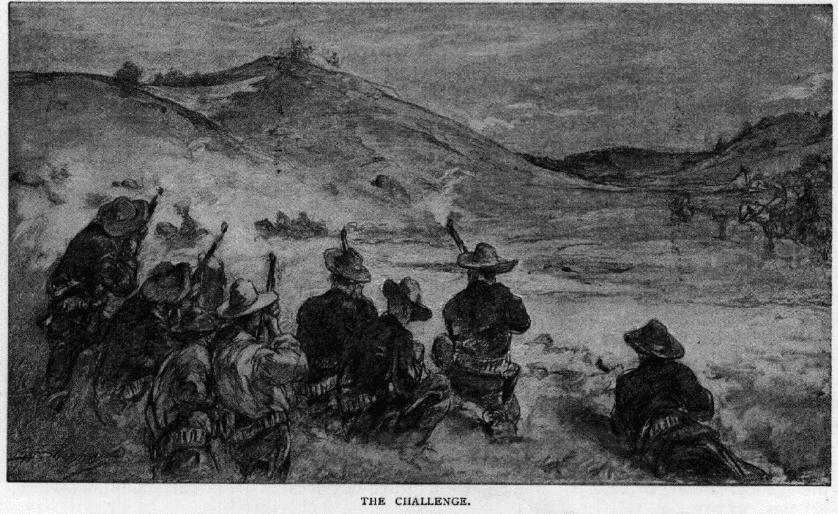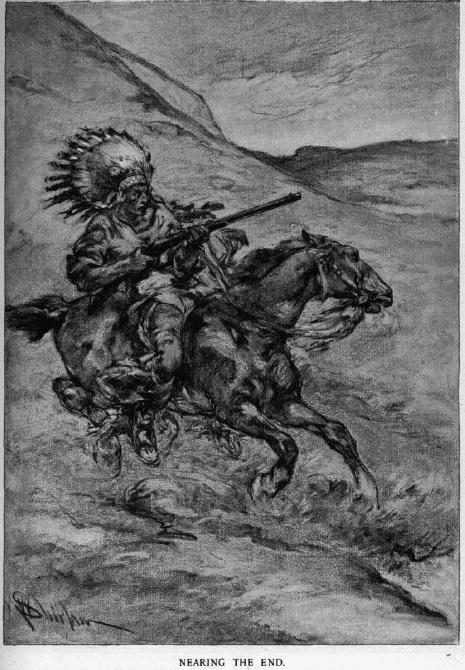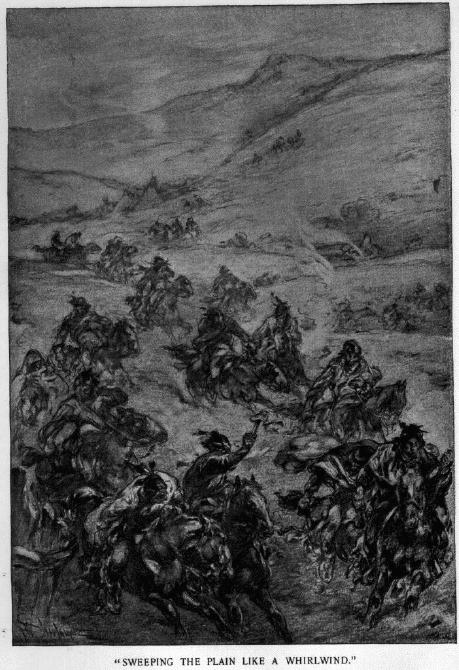| Artists' Adventures: The Rush to Death | ||
ARTISTS' ADVENTURES: THE RUSH TO DEATH.
WITH PICTURES BY THE AUTHOR.
IN the summer of 1890, while making for the United States government an enumeration of the Cheyenne Indian Reservation on Tongue River, Montana, and noting its condition, I was a witness to the following remarkable incident:
On the evening of September 7, a youth named Hugh Boyle was shot and killed by two Cheyenne bucks called Head Chief and Young Mule. Head Chief was so named from his position as leader of a group of bucks who dressed themselves in varied fantastic and picturesque costumes of feathers and paint, their main occupation being to dance a begging dance known as the "Omaha Dance" before the agency. Young Mule, a youth of eighteen, was one of the band, and a close companion of Head Chief, who was really the murderer, Young Mule being only an accessory.
There was no motive apparent for the act, save a savage desire to kill. The lad was unknown to the Indians, having arrived but recently on a visit to relatives, who were old settlers. On the evening of his assassination he was on the way to aid his uncle in herding cattle. It was a dark and dismal night; the road was long and isolated, and he rode on horseback. The horse, still saddled, was found the following day peacefully grazing. This was the first intimation of a mystery. After a fruitless three-day quest in the wooded hills and ravines,
The chiefs were now called upon, and in a few hours American Horse, a prominent chief, reported that the body had been found in a run between two hills, four miles from the agency. Learning this, the agent, accompanied by a force of troops, made the ascent of the hill, a toilsome one, to the spot indicated as the place of burial.
A careful examination was made to determine whether the killing was the act of a white man or a redskin. We saw faintly visible in the fresh earth the marks of a moccasin or bare foot. The Indian chiefs, seated close in a semicircle, were looking on with great alertness. On hearing the decision, they acknowledged at once that it was the deed of two bucks, whose names they said they would divulge at the proper time, which meant when they were compelled to. The body of the boy was then unearthed, placed on an army stretcher, and conveyed to the ambulance waiting below. As the procession passed down the narrow path in single file, the silent tread of the Indians closing in the rear, it was desolate and mournful in the extreme.
The Indians condemned the murder as a cowardly act, and deeply deplored the sad mishap as tending to break the existing peace, and all pledged their faith to aid in bringing the guilty to justice. The Indian police were called together, with additional trusty members of the tribe, and were empowered to arrest the murderers. In twenty-four hours they returned, reporting that the assassins could not be found. On Saturday, the 13th, when the rations were issued, the agent called for a powwow of the chiefs. The meeting was most characteristic of Indian duplicity. They admitted that they knew who the murderers were, and thought they should be punished; but they told nothing definite. During the discussion the father of Head Chief pleaded most pathetically for the life of his son, saying he had tried to bring him up to do right to his American Father, but that he was young and rash. This eloquent appeal was delivered through an interpreter with great dignity. We were all much moved, but the situation was unchanged, when American Horse, a noble-looking Indian, bearing a strong resemblance to George Washington, offered forty ponies as a ransom for the life of the boy. The agent said that that was not justice in the eyes of white men, and expressed his determination to arrest the murderers at all hazards; whereupon the chiefs proclaimed that the two murderers would not be taken alive, but would challenge the troops, and would appear in half an hour "to kill and be killed." The agent rose to his feet, exclaiming, "We are ready; bring on your men."
In an instant the young bucks who had fringed the outer
space
of the agency mounted their ponies, and from camp to camp
conveyed
the word of challenge. Then in haste they sought the rounded
edges
of the hills bordering the western bank of the Lame Deer, seeking
reserved seats in the natural amphitheater.

THE CHALLENGE
[Description: A group of soldiers kneeling on the ground with rifles
pointing into the background. Hills and a hint of Native
American warriors in the distance.]

NEARING THE END
[Description: A Native American chief with a warbonnet and rifle riding a horse at top speed]
"SWEEPING THE PLAIN LIKE A WHIRLWIND"
[Description: A group of Native Americans riding fast, hills in the background.]From these picturesque groups came mournful sounds, mingled with shouts of defiance, as the exodus moved past the agency and sought points of shelter. Everything seemed to have been understood and prepared. The agent gave orders to all, including the Indian police, to arm themselves and prepare for the attack. The military, who were camped a mile below the Lame Deer, were informed, and sent troops. A force of cavalry was also quickly on hand. The aim of the troops, and of the agent, was not to kill the two culprits, but to inclose them on all sides and to secure their arrest. This just and humane desire, as the sequel shows, failed. Suddenly there appeared on a rocky point the two braves, mounted, and arrayed in their war-paint and feathers, daringly facing the unequal fight. They moved with great rapidity from point to point, shouting their battle-cry and firing, while showers of bullets plowed the ground about them. For one full hour this natural fortress was held by them, when, taken in the rear by a troop of cavalry, they were compelled to seek shelter on the plains or wooded hills beyond. Head Chief, still mounted, acted the hero, knowing that in the legends of the witnessing tribe his name would be celebrated as one who died a true brave. Unseen, he crossed the plain, taking flight for the opposite hills, where without warning he met a detachment of troops. The challenge was "to kill and be killed." So it was. Head Chief bit the dust ten feet from the point of encounter. Four bullets had done their work, and the Indian was laid low.
Young Mule, the younger Indian, unmounted, his pony having been shot, was seen bounding like a deer over the uneven ground and tangled sage-brush. He sought refuge in a dry run. Here for an hour, his ammunition still holding out, he kept at bay all who dared his capture. One sad incident preceding his death was the appeal of his mother to save him from impending doom. It was fruitless, none daring to attempt his arrest. Evidently he meant to die as his comrade had died.
His mother, now knowing that her boy was lost, came out on the open plain, her legs slashed and cut from the knee downward, the blood streaming on the ground. While the bullets cut through the brush she chanted and wailed his death-dirge. He fell by the bullet of one of the Indian police, which penetrated his heart. The Cheyenne is brave, and the young bucks died like Spartans.
The agent, the doctor, a lieutenant, an Indian chief, and I viewed the dead. As we approached the body of Head Chief, I saw the gleam of a knife. With sudden frenzy his sister sprang toward us, shielding the body from our gaze. The old chief tried to pacify her, but she burst into tears.
The tragedy over, the multitude, eight hundred strong, came down the hills pell-mell, with colors and dust flying, the young bucks leading the van, sweeping the plain like a whirlwind; the squaws coming on with shrill shouts, chanting their dirges, which mingled with the howling of the dogs,—a scene never to be forgotten.
That night the burial took place, where or how was never known; but far into the night could be heard the funeral rites.
The following morning little mounds of stones were seen dotting the hills and the plain. Head Chief's trail had been followed, and wherever blood had dropped from his wounds a heap of stones had been laid. The spot where he fell was marked with a high mound of stones, and a large feather from his head-dress stood erect on the summit. This was a great mark of respect, because he died facing the enemy. Young Mule died in a hole behind the sagebrush; as this was considered the act of a coward, his grave was left unmarked and his suffering was unnoticed.
| Artists' Adventures: The Rush to Death | ||